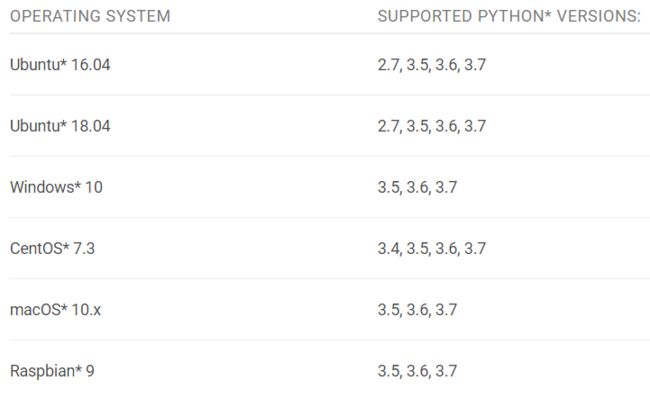OpenVINO FPS也可以达100帧
open_model_zoo:
https://github.com/opencv/open_model_zoo
这两个是安装教程:
https://blog.csdn.net/shanglianlm/article/details/89286218
https://blog.csdn.net/qq_36556893/article/details/89532728
英特尔从去年推出OpenVINO开发框架,从此以后几乎每三个月就更新一个版本,最新版本2019R03,但是此版本跟之前的版本改动比较大,所以在配置Python SDK支持与开发API层面跟之前都有所不同。这里假设你已经正确安装好OpenVINO框架。如果不知道如何安装与配置OpenVINO可以看我在B站视频教程:
https://www.bilibili.com/video/av71979782Python语言支持
01
OpenVINO支持的Python版本SDK与系统列表如下:
首先需要配置好OpenVINO的python SDK支持,这个步骤其实很简单,只需要把安装好的OpenVINO目录下:
openvino_2019.3.334\python\python3.6下的openvino文件夹copy到安装好的python3.6.5的 site-packages 目录下面,然后就可以正常使用啦。注意,上述的配置方式只对Windows下面有效。
推理引擎SDK API
02
API函数列表与说明
其中最重要的是IECore与IENetwork。
在Python语言中导入SDK支持的python代码如下:
from openvino.inference_engine import IENetwork, IECore初始化IE(inference Engine)插件,查询设备支持的代码如下:
ie = IECore()
for device in ie.available_devices:
print("Device: {}".format(device))
执行结果截图如下:
可以看到,在我的电脑上支持的设备还是挺多的,计算棒支持没问题!
在通过ie创建可执行网络的时候,会需要你指定可执行网络运行的目标设备。我们就可以从上述支持的设备中选择支持。这里需要注意的是CPU需要扩展支持,添加扩展支持的代码如下:
ie.add_extension(cpu_extension, "CPU")
创建可执行的网络的代码如下:
# CPU 执行
exec_net = ie.load_network(network=net, device_name="CPU", num_requests=2)
# 计算棒执行
lm_exec_net = ie.load_network(network=landmark_net, device_name="MYRIAD")
这里我们创建了两个可执行网络,两个深度学习模型分别在CPU与计算棒上执行推理,其中第一个可执行网络的推理请求数目是2个,执行异步推理。
人脸检测演示
03
基于OpenVINO的人脸检测模型与landmark检测模型,实现了一个CPU级别高实时人脸检测与landmark提取的程序,完整的代码实现如下:
def face_landmark_demo():
# query device support
ie = IECore()
for device in ie.available_devices:
print("Device: {}".format(device))
ie.add_extension(cpu_extension, "CPU")
# LUT
lut = []
lut.append((0, 0, 255))
lut.append((255, 0, 0))
lut.append((0, 255, 0))
lut.append((0, 255, 255))
lut.append((255, 0, 255))
# Read IR
log.info("Reading IR...")
net = IENetwork(model=model_xml, weights=model_bin)
landmark_net = IENetwork(model=landmark_xml, weights=landmark_bin)
# 获取输入输出
input_blob = next(iter(net.inputs))
out_blob = next(iter(net.outputs))
lm_input_blob = next(iter(landmark_net.inputs))
lm_output_blob = next(iter(landmark_net.outputs))
log.info("create exec network with target device...")
exec_net = ie.load_network(network=net, device_name="CPU", num_requests=2)
lm_exec_net = ie.load_network(network=landmark_net, device_name="MYRIAD")
# Read and pre-process input image
n, c, h, w = net.inputs[input_blob].shape
mn, mc, mh, mw = landmark_net.inputs[lm_input_blob].shape
# 释放网络
del net
del landmark_net
cap = cv2.VideoCapture("D:/images/video/SungEun.avi")
cur_request_id = 0
next_request_id = 1
log.info("Starting inference in async mode...")
log.info("To switch between sync and async modes press Tab button")
log.info("To stop the demo execution press Esc button")
is_async_mode = True
render_time = 0
ret, frame = cap.read()
print("To close the application, press 'CTRL+C' or any key with focus on the output window")
while cap.isOpened():
if is_async_mode:
ret, next_frame = cap.read()
else:
ret, frame = cap.read()
if not ret:
break
initial_w = cap.get(3)
initial_h = cap.get(4)
# 开启同步或者异步执行模式
inf_start = time.time()
if is_async_mode:
in_frame = cv2.resize(next_frame, (w, h))
in_frame = in_frame.transpose((2, 0, 1)) # Change data layout from HWC to CHW
in_frame = in_frame.reshape((n, c, h, w))
exec_net.start_async(request_id=next_request_id, inputs={input_blob: in_frame})
else:
in_frame = cv2.resize(frame, (w, h))
in_frame = in_frame.transpose((2, 0, 1)) # Change data layout from HWC to CHW
in_frame = in_frame.reshape((n, c, h, w))
exec_net.start_async(request_id=cur_request_id, inputs={input_blob: in_frame})
if exec_net.requests[cur_request_id].wait(-1) == 0:
# 获取网络输出
res = exec_net.requests[cur_request_id].outputs[out_blob]
# 解析DetectionOut
for obj in res[0][0]:
if obj[2] > 0.5:
xmin = int(obj[3] * initial_w)
ymin = int(obj[4] * initial_h)
xmax = int(obj[5] * initial_w)
ymax = int(obj[6] * initial_h)
if xmin > 0 and ymin > 0 and (xmax < initial_w) and (ymax < initial_h):
roi = frame[ymin:ymax,xmin:xmax,:]
rh, rw = roi.shape[:2]
face_roi = cv2.resize(roi, (mw, mh))
face_roi = face_roi.transpose((2, 0, 1))
face_roi = face_roi.reshape((mn, mc, mh, mw))
lm_exec_net.infer(inputs={'0':face_roi})
landmark_res = lm_exec_net.requests[0].outputs[lm_output_blob]
landmark_res = np.reshape(landmark_res, (5, 2))
for m in range(len(landmark_res)):
x = landmark_res[m][0] * rw
y = landmark_res[m][1] * rh
cv2.circle(roi, (np.int32(x), np.int32(y)), 3, lut[m], 2, 8, 0)
cv2.rectangle(frame, (xmin, ymin), (xmax, ymax), (0, 0, 255), 2, 8, 0)
inf_end = time.time()
det_time = inf_end - inf_start
# Draw performance stats
inf_time_message = "Inference time: {:.3f} ms, FPS:{:.3f}".format(det_time * 1000, 1000 / (det_time*1000 + 1))
render_time_message = "OpenCV rendering time: {:.3f} ms".format(render_time * 1000)
async_mode_message = "Async mode is on. Processing request {}".format(cur_request_id) if is_async_mode else \
"Async mode is off. Processing request {}".format(cur_request_id)
cv2.putText(frame, inf_time_message, (15, 15), cv2.FONT_HERSHEY_COMPLEX, 0.5, (200, 10, 10), 1)
cv2.putText(frame, render_time_message, (15, 30), cv2.FONT_HERSHEY_COMPLEX, 0.5, (10, 10, 200), 1)
cv2.putText(frame, async_mode_message, (10, int(initial_h - 20)), cv2.FONT_HERSHEY_COMPLEX, 0.5,
(10, 10, 200), 1)
#
render_start = time.time()
cv2.imshow("face detection", frame)
render_end = time.time()
render_time = render_end - render_start
if is_async_mode:
cur_request_id, next_request_id = next_request_id, cur_request_id
frame = next_frame
key = cv2.waitKey(1)
if key == 27:
break
cv2.waitKey(0)
# 释放资源
cv2.destroyAllWindows()
del exec_net
del lm_exec_net
del ie
1920x1080大小的视频画面检测,超高实时无压力!有图为证:



